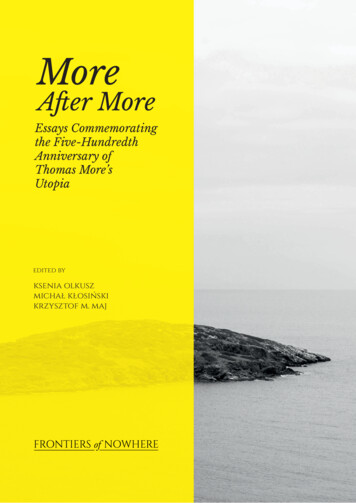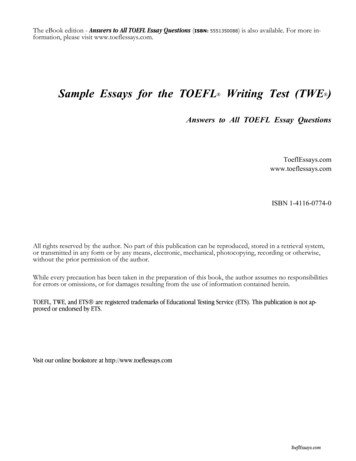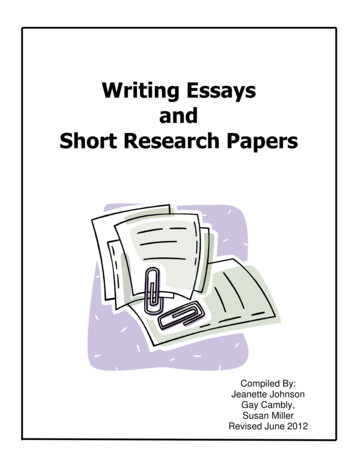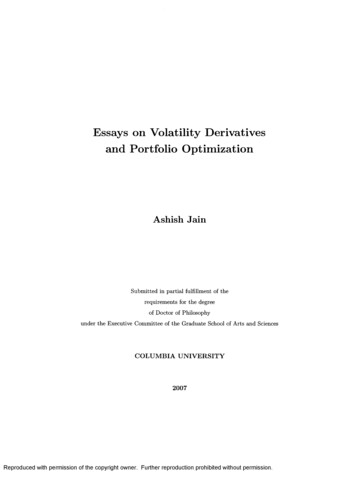
Transcription
MoreA er MoreEssays Commemoratingthe Five-HundredthAnniversary ofThomas More’sUtopiaedited byksenia olkuszmichał kłosińskikrzysztof m. majFRONTIERS of NOWHERE
MoreAfter More
MoreAfter MoreEssays Commemoratingthe Five-Hundredth Anniversaryof Thomas More’s Utopiaedited byKsenia Olkusz,Michał KłosińskiKrzysztof M. Majfacta ficta research centre kraków 2016
Some rights reserved byFacta Ficta Research Centre in KrakówThe book is licenced under Creative Commons BY 4.0(Attribution International) in recognition of Open AccessMovement and stored in the Center for Open Science repositoryReviewed by Prof. Paweł FrelikProofread by Sven Dwulecki and Karolina KwaśnaCataloguing: 1. Philosophy 2. Utopian studies 3. Utopia and dystopiaI. Frontiers of Nowhere (vol. 1) II. TitleIII. Ksenia Olkusz, Michał Kłosiński, Krzysztof M. MajISBN: 978-83-942923-4-8Cover photo: Nikos Patsiouris, Syros 623591)Set in Libre Baskerville and Cinzel open fontsLayout designed by Krzysztof M. Maj
ContentsList of Figures10Preface12Introduction: Utopia at 50014Gregory Claeys1.Evantropia and Dysantropia: A Possible New Stagein the History of Utopias26Lucas Misseri2.The Facets of “Universal Religion”: Religion in Nineteenth-CenturyFrench Utopian Thought44Tomasz Szymański3.Twenty-first Century Critical Dystopias56Peter G. Stillman4.Deconstructing Utopia74Krzysztof M. Maj5.Micro-dystopias as Socio-political Constructsin Post-apocalyptic Narratives90Ksenia Olkusz6.Boredom and Melancholy in Utopias and Dystopias104Mariusz Finkielsztein7.Creating Utopian or Dystopian Worlds in Digital GamesMiłosz Markocki118
8.SimCity: Where the City Ends134Michał Kłosiński9.“Building the Future and Keeping the Past Alive Are One andthe Same Thing”—A Rhetorical Analysis of the Metal Gear Solid Saga148Sven Dwulecki10. Digging the Trench: Fictional Accounts of Utopian Communitiesand Utopian Closure172Verena Adamik11. Classical Utopian Model. On the Melancholy Statusof Jan Parandowski’s Ancient Discourse188Rafał Szczerbakiewicz12. Parodies of Authority in the Soviet Anti-utopias from 1918-1930210Andrzej Dróżdż13. The Analysis of the Element of Space in Negative Utopiasby Antoni Lange, Jan Dobraczyński & Vladímir Páral224Aleksandra Paluch14. Libertarian Utopia and Racist Dystopia: Social Commentaryin Robert Heinlein’s Farnham’s Freehold238Piotr Stasiewicz15. No Light Without Shadow: The Control of Language and Discoursein Margaret Atwood’s Dystopian Fiction252Anna De Vaul16. Senescence in Young Adult Dystopias266Anna Bugajska17. Modern Wastelands: The Psychogeographical Dystopiaof J.G. Ballard’s High-RiseMarcin Tereszewski280
18. The Use of Multimodal Narrative Techniques in Creating DystopianUndertones Permeating David Foster Wallace’s Short Fiction294Maja Wojdyło19. A Utopian, a Martyr or a Fool: Fictional Portrayalsof Sir Thomas More in A Man for All Seasons and Wolf Hall310Barbara Klonowska20. The Pelagian Roots of Utopia—The Problem of Good and Evilin the Novels Pronalazak Athanatika by Vladan Desnicaand Koraljna vrata by Pavao Pavličić322Anna Boguska21. The Elementary Particles: Brave New World According toMichel Houellebecq338Michał Palmowski22. The Unusual Dystopia of Never Let Me Go (2010)352Eleni Varmazi23. Transmetropolitan. Dystopia, Hyperbole, and the Superhero364Justyna Galant24. Liberation, Redemption, Autonomy: Contemporary Utopiasin Southern Italian Popular Music376Marcello Messina25. Arnold Schoenberg’s Dodecaphonic Method as a Representationof an Artistic Utopia394Iwona Sowińska-Fruhtrunk26. Space Utopia in the 1970s of the Twentieth Centuryon the Basis of the Kobaïan World406Łukasz StecContributors420
List of FiguresTable 1. Diachronic transformation of utopian goals34Table 2. Utopian and dystopian narratives juxtaposed with thelogocentric instances81
PrefaceThe book More After More. Essays Commemorating the Five-Hundredth Anniversary ofThomas More’s Utopia is the first volume of the new publishing series “Frontiers ofNowhere” designed by Facta Ficta Research Centre in Kraków (factaficta.org/en) toprobe the boundaries of fictional world-building and contemporary narrative theories. More After More summarizes also three years of His Master’s Voice research projectrun by the editors of this volume and featuring three conferences in utopian anddystopian studies (in 2014, 2015, 2016), supported by Jagiellonian University’s Facultyof Polish Studies as well as AGH University of Science and Technology’s Faculty ofHumanities. In the special 2016 issue of the esteemed Utopian Studies journal, On theCommemoration of the Five Hundredth Anniversary of Thomas More’s “Utopia”, the projectwas recognized in the report Utopian Studies in Poland: A Preliminary Survey by a Prof.Artur Blaim from the University of Gdańsk, whom we would like to express our many thanks for such kind support. Additionally, our project has greatly benefited fromhelp and guidance offered to us by Prof. Gregory Claeys, Prof. Anna Łebkowska,Prof. Barbara Gąciarz, Prof. Zbigniew Pasek and Dr Danuta Glondys. It is also thereviewer of the volume, Prof. Paweł Frelik, whom we owe our gratitude for takingcare of high-quality, in-depth reviews of all chapters, which have greatly helped todeliver the very best value from the contributed manuscripts. Last but not least, thosesuccesses would not be possible without the attendees of His Master’s Voice annualconferences, whose promising presentations were selected for further developmentas chapters for More After More. Thank you all and also to those of you whom wecould not have included in this short list—you really help us shaping a true bravenew world in the contemporary humanities.The last edition of His Master’s Voice conference, More After More. Utopias & Dystopias 1516-2016, as well as the publication of this book, were supported by Villa Decius Association, greatly involved in a plethora of successful research projects partnered with the Visegrad Group, as well as by Utopian Studies Society’s international
preface13initiative “Utopia 500” (utopia500.net). We are proud to co-operate with people fromboth the academia and its outsides who support a community-driven spirit of research and work on transgressing the boundaries that lie foundations for walls andbarriers—which are nothing but corner stones for future totalitarian dystopias andintellectual regimes.Correspondingly, More After More, as well as the series “Frontiers of Nowhere”,is meant to be published in full open access and distributed freely in multiformat, aswe believe that the current model of high-cost (for publishers, authors, and readersalike) academic publishing creates a false sense of elitism by restricting the access toknowledge only to the affordable few. Utopian studies deprived of the openness arean unintended contradiction—they rather shape a dystopia by walling off from theoutside and enjoying a splendid isolation for a small group of beneficiaries.We hope that this volume will grant the readers an insight to contemporary interdisciplinary research in utopian and dystopian studies across media, both in theirphilosophical and artistic dimension—and that it will inspire more research in thisrelatively small, but important branch of humanities.Editors
introductionUtopia at 500Gregory ClaeysThe little book we now familiarly refer to as Utopia was published five hundred yearsago in Leuven, the capital of what is today the Flemish province of Brabant in Belgium 1. As a work of fantasy it has had an astonishingly successful history. As both theno-place and the good-place, then eventually perhaps also the place-one-shouldnot-go, the dream which becomes a nightmare when we try to realise it, utopia hasbecome inscribed in our vocabulary and our ideas. It means many things to manypeople, yet few would deny the power of the concept. So it is worth briefly revisitingjust how this has mutated over the centuries.Firstly then to Sir (or Saint) Thomas and his ideas. The text is presented to us inthe form of a dialogue in which the central narrative about the society called Utopiaappears in Book Two, when the travels of Raphael Hythloday are related to a rathersceptical Thomas More. (But which, we immediately ask, is the real More in thisschizophrenic division?). More commences Utopia with an account of the desperation of the poor in the England of his day, in Book One. We are quickly made awareby the mention of Amerigo Vespucci that recent travellers to the new world havebrought back fantastic but compelling tales of their discoveries. Some hinted thatconditions were akin to the golden age of Greek mythology, the very opposite, thus,1The substance of this introduction was presented at His Master’s Voice annual conference at the Villa Decius in Krakowin March 2016. I am grateful to Ksenia Olkusz, Michał Kłosiński and Krzysztof M. Maj in particular for their commentsat this meeting.
introduction: utopia at 50015of contemporary England. More would have known of Peter Martyr d’Anghiera’s DeOrbe Novo (1511), a description of the natives of Cuba as having community of goods,and there were other assorted rumours of this type. Few would today describe Utopia’s inhabitants as noble savages. But Utopia does appear to be just such a tale: itprojects an island lying somewhere in the equatorial regions, founded both by shipwreck and the wise design of the great mariner Utopus many centuries earlier. Whenwe recall that Columbus thought the earthly paradise lay just beyond the mouth ofthe Orinoco river More’s postulate seems if anything less fantastic.The constitution and mores of Utopia appear to owe more to classical antiquitythan to the customs of the aboriginal Americans. Yet their peculiarities betray threefeatures which some contemporaries supposed did define native life in the newworld, and which have been attached to our image of utopia ever since. These are:community of goods; an apparent contempt for gold and silver and ostentatiouspride generally; and the abolition of money. The discovery of the new world fromone viewpoint could indicate that the turning away from apostolic communism hadbeen a tragic error. As we are all aware, the travel literature which served as a backdrop to More’s text—and most notably the tradition of Sir John Mandeville’s Travels—was replete with fantastic lands. The names More gives, firstly to Utopia itself,then to its capital, Amaurot (obscure or unknown) suggests a satire on this traditionas such. But then the introduction of Vespucci returns us to a realistic set of presumptions. Yet Utopia, far from being the perfect society with which it is still too oftenconfused, is not even the best possible society, given the prevalence of war and slavery in particular.Whilst the ethos of friendship and trust which defines Utopia is always commendable, it is also by no means obvious that communism is the answer to the woesof England as described in Book One, where More laments the poor are being hungen masse as great landlords drive them off the land to enclose the commons for highlyprofitable sheep raising. Communism is the theme which appears to bring the Utopians close to Apostolic Christianity, or to being more Christian, in other words, thanMore’s contemporaries. But communism is also what More, on balance, finds leastplausible in Hythloday’s tale: how, he asks near the end, can these Utopians really bemotivated without the ownership of property? And if this regime of common endeavour works here, he hints as the book closes as to his scepticism as to whetherEuropeans could live this way, converting from their opulence and love of pleasureto this superior Platonic and Christian life. This vision remains to More a tantalising
16gregory claeysand fascinating one. But to many readers the two islands of Britain and Utopia havetoo little in common to imagine that the model is meant to be imitated.Utopia of course has several other leading themes which merit mention. Its inhabitants divide their time between fifty-four almost identical towns and cultivationin the countryside. They dress, eat, work, and behave in remarkably similar ways.They combat vice by a regime of near-complete transparency, leaving no space inwhich crime and vice might flourish. In Utopia, we are told, there are “no wine bars,no pubs, no whorehouses. There are no opportunities for wickedness, no hiding places; there is no scope for conspiring in secret. They are always under the observationof their fellow citizens and have no choice but either to work as hard as the nextperson, or else engage in respectable pastimes” (More 1999: 108). We cannot traveloutside our neighbourhood without passports. We must wear the same plain clothes.We must exchange our houses every ten years. We cannot avoid labour. We all go tobed at the same time (8 p.m.), and never, under penalty of slavery, with someoneelse’s wife or husband. In More’s time, for much of the population, such restraintswould not have seemed overly unreasonable. For modern readers, however, Utopiaappears to rely upon relentless transparency, severe regulation, and the curtailmentof privacy. In both its external and internal relations, thus, it seems perilously dystopian 2.Utopia, then, is not really a f u n place. It is a s a f e place. It offers repose. But theprice is restraint. Moreover, Utopia remains an imperial power. When overpopulated it sends out colonies, seizing the uncultivated land of indigenous peoples, anddriving out “any who resist them” (More 1999: 103). Well-paid mercenaries keep enemies at bay, the Utopians’ much-vaunted contempt for gold here standing starklyin contrast with the great value their treasure has when expended on slaying theirenemies. Utopia’s peace and plenitude now seem to rest upon war, empire and theruthless suppression of others, or in other words, their dystopia. And there are otherlimits to their generosity. The Utopians are tolerant in most matters of religion. Butthey despise those who deny the immortality of the soul because “but for the fear ofpunishment, they would have nothing but contempt for the laws and customs of society” (More 1999: 147) Intolerance is the price we pay for the purity, homogeneity2These paradoxes are explored in my Dystopia: A Natural History (Claeys 2016).
introduction: utopia at 50017and closeness of the group, as More made all too evident in his (nonetheless consistent) persecution of Protestants in his own day.Nonetheless perhaps More’s text is just an entertaining story. Generations ofscholars have reached no fixed opinion as to how seriously More meant us to takethese themes. There is much jest and satire mixed up in the text. There is little doubtthat More regarded much of Utopian life as ideal, but much more than he thoughtthat most of it was attainable by most of us. Yet More’s intentions, and a close contextual reading of Utopia, are perhaps secondary to most students today by comparison with the influence of its central ideas.The most common reading of the text, from Vasco de Quiroga, who adaptedUtopia as a blueprint to establish a community near Mexico City in the 1530s 3 toRobert Southey to Karl Kautsky and beyond, has been the realistic one, in which Hythloday serves as prophet of the communist ideal. The reasons for this are not hardto discern. The success of utopia coincided with a decline in the belief that the terrestrial paradise actually lay somewhere in this world. It also overlapped with repeated eruptions of the sentiments, often assuming the form of a hysterical megalomania, which we associate with millenarianism, the prospect of Christ’s return, the overthrow of Satan, and the establishment of divine rule.These have a lengthy pedigree. The millenarian wing of the utopian ideal datedas far back as the twelfth century vision of Joachim of Fiore, who divided history intothree stages, those of the Father, Son, and Holy Ghost, and for whom the third, paradisical period, where there would be no work, wealth or poverty, and no food, eachhaving evolved into a spiritual being. In 1936 Karl Mannheim and in 1947 NormanCohn were amongst the first to identify the sixteenth-century Anabaptists with thesecularisation of millenarian ideas, heralding the great utopian schemes and movements of the twentieth century (Mannheim 1936: 191-192). The seventeenth centuryechoed constantly with utopian schemes, plans, ideas and sentiments, from Baconthrough Winstanley and Harrington to Bellers, Penn and Saint-Pierre. In the 18thcentury the belief in an original equality was powerfully reinforced by Jean-JacquesRousseau in particular. Then, in the nineteenth century, faith in a future heaven alsobegan to wane, and with it millenarianism, which had thus necessarily to be secularised. The desire for a much better state for humanity became naturally fixated on3The story is told in Toby Green. Thomas More's Magician. A Novel Account of Utopia in Mexico (2004).
18gregory claeysthe real present and future, on this world. Now, as Henri de Saint-Simon famouslyproclaimed the Golden Age of mankind lay not “behind us, but before; it lies in theperfection of the social order” (de Saint-Simon 1976: 98).Utopia thus came to embody the principle of equality, and of the purity of thegroup defined by its beliefs, which were formerly represented by Christianity. Thereis a reasonable case here for seeing what Reinhart Koselleck termed the “temporalization of Utopia”, “the metamorphosis of utopia into the philosophy of history”,where the “imagined perfection of the formerly spatial counterworld is temporalized” in the eighteenth century, as a key stage in millenarian secularisation (Kosseleck2002: 85, 88). Yet there remained, and perhaps still remains, much confusion between the millennium and utopia. The leading communist in the French Revolution,Gracchus Babeuf, aimed to abolish “all frontiers, fences, walls, locks on doors, all disputes, trials, all theft, murder, all crime, all Tribunals, prisons, gallows, torture, jealousy, insatiability, pride, deceit, duplicity, finally all vice”—a “classic millennial vision” of boundless felicity, in Richard Landes’ phrase (2011: 290). But utopia was acondition of bounded felicity, of restraint and self-restraint. What the “millennialshock wave” of the French Revolution shared with utopia was a suddenly explodingegalitarianism, described in terms of the mass hysteria of the crowd by Gustave LeBon, which reverberated through European history for the next two centuries (Landes 2011: 288).The stages on the road to the present will be familiar to most readers of thisjournal. In the early modern period the utopian idea, as we might conceive it today,was often still identified with the provision of security and stability through the creation of institutions which once formed became immutable. Satires aside, those seventeenth- and eighteenth-century literary utopias which reflected More’s aims seriously tended to regulate luxury through sumptuary laws restricting personal consumption and adornment, and by limiting property ownership in land especially (James Burgh’s Account of the Cessares from 1764 is a typical example). In Britain in particular, many literary texts reflect the aims of a republican tradition defined in thisepoch especially by the works of James Harrington, whose Oceana of 1656 offered aloosely-fictionalised constitution enjoining greater social equality and political representation. Utopian republicanism had by 1750 become a distinctive position, goingbeyond the notion of an agrarian law to community of goods. But in practice authorsof fictional utopias toyed with many variants on these themes, including land nationalisation (Thomas Spence). The most transparent and rigidly controlled of these
introduction: utopia at 50019schemes generally however have little appeal to modern readers, who expect thatutopia and liberty are somehow natural partners in the first instance, and disagreethat liberty is a just price to pay for equality.The French Revolution of course represents the first great watershed in themodern development of the utopian idea into this direction. Here a republican constitution accompanied an ideology based upon the “rights of man” which some haveassumed possessed a markedly utopian dimension (see Moyn 2010). The shift towards a much more radical ideal of equality which the Jacobin coup of 1792 producedalso echoed the central theme we identify with the tradition as such. And beyond thisthere were new, massive popular festivals, an ethos of increasingly social transparency, and much else that reflected the utopian impulse. But here there loomed, too,the possibility that utopian aims might have dystopian results, with the emergenceof Jacobin Terror under Robespierre (1793-1794). But the Revolution in general alsoindicated that crucial trend towards seeing utopian aims as realisable imminently ina future-to-come, rather than as being the discovered vestiges of a lost golden age orstate of nature or a tropical paradise, or a future heaven to be achieved. Utopia nowbecame e u c h r o n i a , the good time which is not yet but upon which we are advancing. The modern concept of progress, an indefinite process of becoming better andmore perfect, our own most cherished ideal, though sadly on its deathbed today, hademerged. Now we would remake mankind, not in the image of Original Sin, but inthat of millenarian felicity.The story of utopia’s advancement from this time is a familiar one to most ofus, for we are its adherents and beneficiaries to an impressive degree. The main forkin this road came of course with the revolution of 1848 and even more that of 1917,when the communist version of progress came finally to offer itself as the great alternative to the supposed free-market variant offered by liberalism. A general courseof increasing perfectibility through opulence, the extension of life, the remaking ofthe human body and the relief of pain might clearly fly as a utopian programme. Butthe enhanced Morean variant of this, achieving all this and adding the elimination ofcrime, for instance, was clearly inherited by Marxism. This became the dominantoppositionist ideology of the twentieth century. Even before the Bolshevik Revolution, however, the immense controversy surrounding Edward Bellamy’s LookingBackward 2000-1887 (1887) indicated that other collectivist variants on the management of modern economies could give Marx some competition in the ideologicalarena.
20gregory claeysMarx himself of course denied that his own schemes were in any sense “utopian”, and castigated his socialist predecessors for refusing to harness the proletariatto the revolutionary means required to introduce the new system. But in its expectation of dramatic improvements in human behaviour engineered by a collectivistorganisation of property Marx in fact merits the utopian title if anything rather morethan those who supposed such achievements might be workable in the small-scalecommunity. And even Marx remained intrigued in his final years by the prospectthat modern communism might indeed have antecedents in the Russian mir andother forms of primitive communalism.Nonetheless it was precisely in such communities that the nineteenth centurysaw utopia unfolding. To spend a day in one, most notably in the Fourierist phalanstère, was, in principle, to encounter a varied routine of multiple forms of work, adjusted to our aptitudes. There would be five or so meals; cultural activities; and aCourt of Love assuring us all a minimum of sexual gratification akin to a living wage.Here is no languor, no lethargy, no world-weariness, only joi de vivre. The Owenites,the Cabetists, not to say the Shakers, Etzlerites, Harmonists and a hundred strands ofreligious sectarians, offered many variants on these themes, though Fourier doubtless promised more fun than the rest. All, however, offered security, a Gemeinschaftvariant on community, or what I call “enhanced sociability”, by contrast to the increasingly alienated, insecure urban society which was rapidly emerging (Claeys2013). In this vision of the idealised village or small town there is often joy, celebration, creativity, even individuality, not merely security, equality and a sense of greater community. Trust and familiarity are permitted because the scale remains small.Politics remain personal because no coercive state is necessary. William Morris,amongst others, would imagine that even nations could be remade along the lines ofsuch principles.And yet, with a few notable exceptions (the Amish, the Hutterites, the two million Mennonites), many of these communitarian efforts failed, often very quickly.But the exceptions here also prove that communism does work on a small scale. Thelack of bloodshed generally in so-called “utopian” socialism validates such experiments to a considerable degree, while hinting that the application of their principlesto a large-scale, highly industrialised, urban context, at a national level, may wellprove their undoing. Both Bellamy and Wells nonetheless projected national andworld-states, respectively, in which both technological innovation, change and, par-
introduction: utopia at 50021ticularly in Wells’s case, individuation were combined with the earlier goals of utopia. Their visions proved immensely influential in the decades from the 1890s to1914, when the progress of the civilised world in general came suddenly to a crashinghalt. We should remember generally here too, however, that the more equal societiesare the more trust can be expanded on a larger scale. Where everyone is aware thatmost are sufficiently well off not to resort to crime paranoia is minimised and general social relaxation is enhanced.The twentieth-century engagement with utopia was multi-faceted. On the onehand Bolshevism proved a disastrous model for a more egalitarian variant on modernisation which ultimately swallowed some eighty million lives, most notably in theUSSR, China and, proportionately worst of all, Cambodia. Many on the left in particular do not like to confront such facts. But such unwillingness falls little short ofintellectual dishonesty: such a confrontation must be an indispensable prerequisitefor continuing the study and promotion of utopia. Apologies for Stalinism, the refusal to acknowledge the nature and devastating impact of left “totalitarianism”, donothing to serve utopianism, and indeed undermine it. For this cedes to utopia’s critics, most notably from Hayek, Popper and Talmon onwards, much ground whichmight be contested, but refusing to acknowledge that the pursuit of some utopias hasbeen disastrous, while that of many others has not.On the other hand the tradition of progress which utopia helped to produceopened up vistas of scientific and technological improvement which assured greaterhealth, longevity and (we suppose) happiness for large numbers of people. As thecentury closed, however, the spectre of totalitarian dystopia gave way to a far morehumbling confrontation with nature itself, as environmental destruction came topose an even greater threat to humanity’s long term prospects than either politics ortechnology had previously done. Yet the scope for utopian thinking, for imagininglong term futures, is consequently more necessary than ever before. Utopia preciselyprovides the possibility of leaping forwards to envision which futures might be attained and which might be avoided. In perilous times this is a tradition which weneed more than ever.***The twenty-six essays which compose this collection cover a substantial rangeof both historical and theoretical themes, indicating at the least that the utopian idea
22gregory claeysthrives today across a number of disciplines as well as in domains (like computergames) which are themselves of recent origin and which indicate that utopia can alsobe addressed as an aspect of the internal psychic fantasy world. There is some consideration here of the lengthy and complex historical relationship between utopianideals and religion. There is some effort to reconsider practical efforts to found actual communities which embody utopian ideals. Several authors revisit the emotional substrata of utopian aspiration rendered accessible through music in particular. Literature is here nonetheless the chief focus, in keeping with the form ofThomas More’s original text and that of the tradition which has imitated and satirised it. The themes represented here mirror in literary form the dystopian drift inthe external world discussed above. Many of the leading authors of post-totalitariandystopian fiction are included here, notably (to name but a few) Margaret Atwood,Robert Heinlein, J.G. Ballard, David Foster Wallace and, most recently, MichelHouellebecq. Within these treatments, the possibilities are explored that dystopiamay emerge from or assume the form of racist regimes, environmental destruction,corporate dictatorship, or religious fundamentalism, or some combination of thesefactors. Such potential outcomes of modernity need, the authors of this volume alsoassure us, to be balanced against the utopian promise which bodily remodelling entertains, and the possibility of longevity which scientific and technical advances encapsulate as the epitome of modern individualist utopianism. From the first essayonwards, we frequently revisit the theme of scientific novelty and improvement assimultaneously both an (e)utopian and a dystopian theme. From this viewpoint thepost-totalitarian literary dystopia not only overlaps more closely with real world developments than many of its pre-totalitarian emanations. It also claims a differentpedigree, looking, for instance, more to Aldous Huxley’s Brave New World (1932) forinspiration than to George Orwell’s Nineteen Eighty-Four (1949).These trends also indicate, however, a declining interest in contemporary utopianism as a r
Firstly then to Sir (or Saint) Thomas and his ideas. The text is presented to us in the form of a dialogue in which the central narrative about the society called Utopia appears in Book Two, when the travels of Raphael Hythloday are related to a rather sceptical Thomas More. (But which, we i










